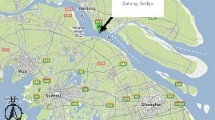Abstract
In this paper, wind-induced vibration control of a single column tower of a cable-stayed bridge with a multi-stage pendulum mass damper (MSPMD) is investigated. Special attention is given to overcoming space limitations for installing the control device in the tower and the effect of varying natural frequency of the towers during construction. First, the finite element model of the bridge during its construction and the basic equation of motion of the MSPMD are introduced. The equation of motion of the bridge with the MSPMD under along-wind excitation is then established. Finally, a numerical simulation and parametric study are conducted to assess the effectiveness of the control system for reducing the wind-induced vibration of the bridge towers during construction. The numerical simulation results show that the MSPMD is practical and effective for reducing the along-wind response of the single column tower, can be installed in a small area of the tower, and complies with the time-variant characteristics of the bridge during its entire construction stage.
Similar content being viewed by others
References
Achkire Y, Bossens F and Preumont A (1998), “Active Damping and Flutter Control of Cable-stayed Bridges,” Journal of Wind Engineering and Industrial Aerodynamics, 74: 913–921.
Ankireddi S and Yang HTY (1996), “Simple ATMD Control Methodology for Tall Buildings Subject to Wind Loads,” Journal of Structural Engineering, ASCE, 122(1):83–91.
Cao H, Reinhorn AM and Soong TT (1998), “Design of an Active Mass Damper for a Tall TV Tower in Nanjing, China,” Engineering Structures, 20(3): 134–143.
Datta TK and Pourzeynali S (2002), “Control of Flutter of Suspension Bridge Deck Using TMD,” Wind and Structures, 5(5): 407–422.
Den Hartog JP (1947), Mechanical Vibration, 3rd ed, McGraw-Hill: New York.
Dyrbye C and Hansen SO (1997), Wind Loads on Structures, John Wiley & Sons, Chichester, England.
Ernst HJ (1965), “Der E-modul von Seilen unter Berucksichtigung des Durchhanges,” Der Bauingenieur, Berlin, 40(2):52–55 (in German).
Feng MQ and Zhang RC (1997), “Wind-induced Vibration Characteristics of Nanjing TV Tower,” Journal of Non-linear Mechanics, 32(4):693–706.
Frahm H (1911), Device for Damping of Bodies, U.S. Patent No. 989, 958.
Gu M et al. (1998), “Increase of Critical Flutter Wind Speed of Long-span Bridges Using Tuned Mass Dampers,” Journal of Wind Engineering and Industrial Aerodynamics, 73(2): 111–123.
Larose GL, Larsen A and Svensson E (1995), “Modelling of Tuned Mass Dampers for Wind-tunnel Tests on a Full-bridge Aeroelastic Model,” Journal of Wind Engineering and Industrial Aerodynamics, 54/55: 427–437.
Larsen A, Svensson E and Andersen H (1995), “Design Aspects of Tuned Mass Dampers for the Great Belt East Bridge Approach Spans,” Journal of Wind Engineering and Industrial Aerodynamics, 54/55: 413–426.
Lu LT and Chiang WL (2003), “Active Control for a Benchmark Building Under Wind Excitations,” Journal of Wind Engineering and Industrial Aerodynamics, 91: 469–493.
Ormondroyd J and Den Hartog JP (1928), “The Theory of the Dynamic Vibration Absorber,” Transactions of the ASME, 50(7): 9–22.
Pourzeynali S and Datta T K (2002), “Control of Flutter of Suspension Bridge Deck Using TMD,” Wind and Structures, 5(5): 407–422.
Qu ZQ (2001), “An Efficient Modelling Method for Laminated Composite Plates with Piezoelectric Sensors and Actuators,” Smart Materials and Structures, 10: 807–818.
Rasoulis K and Yahyai M (2002), “Control of Response of Structures with Passive and Active Tuned Mass Dampers,” The Structural Design of Tall Buildings, 11: 1–14.
Shinozuka M and Jan CM (1972), “Digital Simulation of Random Processes and its Application,” Journal of Sound and Vibration, 25(10): 111–128.
Soong. TT, Reinhorn AM, Aizawa A and Higashino M (1994), “Recent Structural Application of Active Control Technology,” Journal of Structure Control, 1(2): 15–21.
Spencer BF and Sain MK (1997), “Controlling Buildings: a New Frontier in Feedback,” Journal of Control System, 17(6): 19–35.
Thompson AG (1981), “Optimum Tuning and Damping of a Dynamic Vibration Absorber Applied to a Force Excited and Damped Primary System,” Journal of Sound and Vibration, 77: 403–415.
Warbuton GB (1982), “Optimal Absorber Parameters for Various Combinations of Response and Excitation Parameters,” Earthquake Engineering and Structural Dynamic, 10:381–401.
Wu JC and Yang JN (2000), “LQG Control of Lateraltorsional Motion of Nanjing TV Transmission Tower,” Earthquake Engineering and Structural Dynamics, 29: 1111–1130.
Yang JN and Giannopoulos F (1979), “Active Control and Stability of Cable-stayed Bridge,” Journal of Engineering Mechanics, ASCE, 105(4):795–810.
Author information
Authors and Affiliations
Corresponding author
Additional information
Sponsored by: Area Strategic Development Program in Structural Control and Intelligent Building from The Hong Kong Polytechnic University, and National Natural Science Foundation of China Under Grant No. 50408011
Rights and permissions
About this article
Cite this article
Guo, A., Xu, Y. & Li, H. Dynamic performance of cable-stayed bridge tower with multi-stage pendulum mass damper under wind excitations — I: Theory. Earthq. Engin. Engin. Vib. 6, 295–306 (2007). https://doi.org/10.1007/s11803-007-0747-x
Received:
Accepted:
Issue Date:
DOI: https://doi.org/10.1007/s11803-007-0747-x




